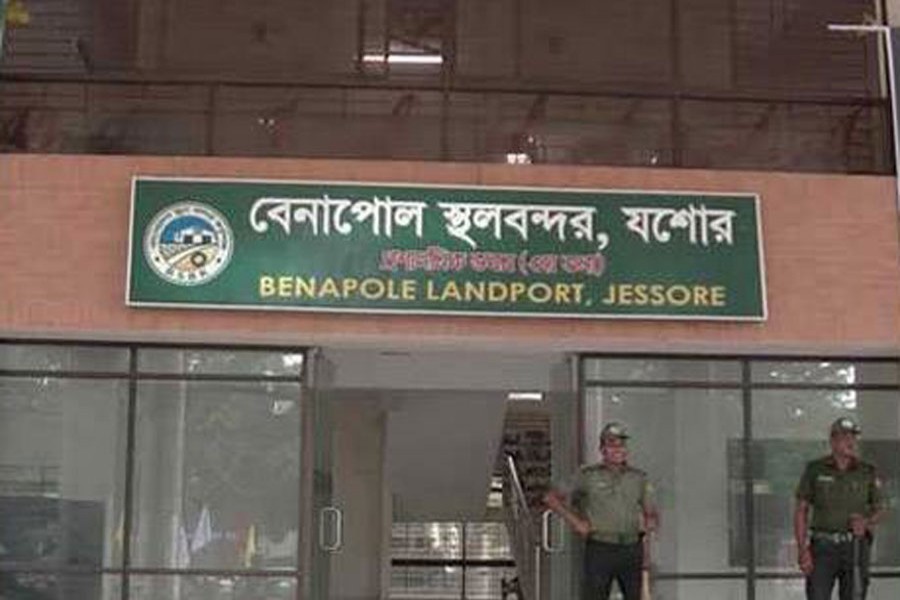The inadequacies of the land customs stations (land ports) in facilitating cross-border trade have been a matter of concern for long. Being landlocked from all but the southeast side, Bangladesh's bilateral trade is heavily dependent on the cross-border land ports with its immediate neighbour, India. Except bulk cargo, a good number of traded products, especially the perishable ones, are better suited for over-land transportation, because of cost-effectiveness and lead time advantage. The situation has indeed improved from what it was half a decade ago, but absence of long-term measures by way of appropriate infrastructure has resulted in only temporary improvements which could not cope with the increased and diverse nature of facilitating requirements.
At present the number of land ports in the country is 23. The busiest one, Benapole land port caters for more than 70 per cent of the traded cargo. Despite some persisting odds for long -- related mostly to the deficient facilities on the Indian side of the border, Petrapole -- the situation is at its best functional. The Akhaura land port neglected for long is presently gaining increasing attention as export traffic from Bangladesh finds the route easier for the Indian state of Tripura. As for most of the land ports, except Benapole, the maladies are more or less common -- absence of proper approach roads for heavy vehicles and trailers, lack of sufficient warehousing facilities, inappropriately located places for loading and unloading of cargo, lack of weighbridge and so on.
As a result, many of the LCSs are presently sitting idle in the absence of export-import operations. It could be learnt that permission for opening a good number of these stations was given because of persuasion by influential quarters and many of those are used only once or twice a year. The LCSs were opened without carrying out feasibility study as regards their utility in cross-border trade.
It has been gathered that the NBR is contemplating reduction in the number of non-functional and inactive LCSs and improving the facilities in some of the active ones. Needless to say, the process is taking too long.
The Cabinet Division of the government, reportedly, recommended way back in 2013 that the NBR close down all the inactive LC stations and not set up a new one within 50 kilometres of the existing ones. Understandably, the NBR has its own home work on how to go about. All it now requires is quick implementation, not just by closing the inactive LCSs but revitalising the active and prospective ones with all required facilities.
While closing down the inactive and unnecessary land ports requires immediate attention, adding more facilities to the functional ones calls for quick actions. Keeping the non-functional ones with no trading operation costs the government money and human resource, and doing away with these would make the government well disposed of towards concentrating more on the functional land ports.
Another key reason often attributed to the less than adequate facilities is that not all the land ports are operated and controlled by a single authority, the Land Port Authority of the government. In fact, except for the Benapole land port, development of the remaining ports lies with private agencies under built-operate-and-transfer (BOT) mechanism. Another pertinent problem often overlooked in this regard is that development of the land ports on the Bangladesh side would only meet half of the facilities required for unhindered bilateral trade. Unless the corresponding land ports on the Indian end are simultaneously developed, including posting of customs and immigration personnel as well as synchronisation of working hours on both sides, building adequate infrastructure on the Bangladesh side will not be of much help, especially for export merchandise. This is not to say that development on the Bangladesh side should be stalled till such time the corresponding ports on the other side are developed.
While it is important to ensure that the private operating agencies accomplish their activities on a priority basis, the government should also be engaged with the Indian authorities in order that facilities in tandem are also in place on the Indian side. This should be high on the agenda of the Customs officials' meeting of both countries that takes place once a year. It has been learnt that there are Customs core groups to look after specific land ports on a zonal basis and to identify the inadequacies. Unfortunately, things have not moved far enough although reportedly, work plans on both sides towards development of the land ports have been chalked out. There is evidently a lack of monitoring and follow-up actions. In the interest of free flow of bilateral trade, it is highly important that port facilitation gets the attention it deserves.


